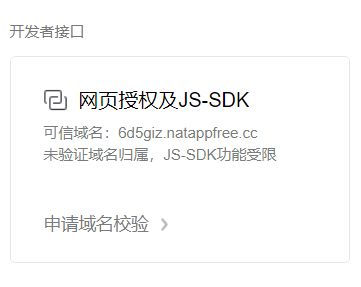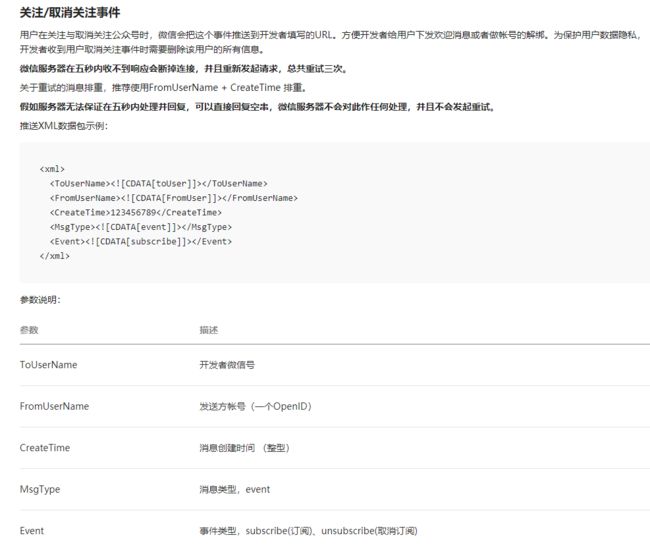最近在开发微信企业号,刚接触时云里雾里的,在摸索过程中终于清晰了一点。
刚开始我以为订阅号、服务号、企业号的接口差不多,就一直用订阅号的教程来入门,后来才发现差的挺多的。
首先,微信企业号不像订阅号和服务号,就一个主页面。企业号的开发其实是对应用的开发。
先附上微信企业号开发官方文档:https://qydev.weixin.qq.com/wiki/index.php
一、企业微信管理页面配置
网址:https://work.weixin.qq.com/wework_admin/frame
1、在注册完企业号后,先创建一个应用
2、在应用管理--自建的应用中配置可信域名
需要注意的是,微信公众号的开发测试需要访问到外网的服务器,且端口只能为80。
这里推荐使用 natapp进行配置,具体使用看 :https://blog.csdn.net/qq_33922980/article/details/90244160 (自备域名的可以忽略)
启动后,填写可信域名
3、配置接收消息的api(这里我已经配好了)
Token和EncodingAESKey可以使用随机获取,url填写刚刚配置的可信域名,及准备调用的接口。
此时点击保存,会提示服务器异常,请稍后再试。
这是由于点击保存时,微信会向我们添加的url发送一个get请求,需要我们返回值。
附上官方说明:
附上url检验代码:
1 @RequestMapping(method = RequestMethod.GET) 2 @ResponseBody 3 public String checkToken(@RequestParam(name = "msg_signature") String signature, String timestamp, String nonce, String echostr) throws AesException { 4 //token和encoding_aeskey就是上诉随机获取的值,corp_id是企业id,在企业微信管理页面点击: 我的企业,拉到最下方可以看到 5 WXBizMsgCrypt wxcpt = new WXBizMsgCrypt(TOTKN, ENCODING_AESKEY, CORP_ID); 6 String sEchoStr = wxcpt.VerifyURL(signature, timestamp,nonce, echostr); 7 System.out.println("-----签名校验通过-----"); 8 return sEchoStr; 9 }
其中,WXBizMsgCrypt是官方提供的加解密库,下载地址:https://qydev.weixin.qq.com/download/java.zip
为方便使用,我直接打成了jar包,有需要的自取。链接: https://pan.baidu.com/s/1Xtzd69T8jVL3w8Kg1jnreQ 提取码: jeeu
再点击保存,就通过了。
此时后台管理的配置完成。
二、实际功能开发
1、回调模式
该url的调用有两个,一个是上述的url检验时调用,第二个是回调模式调用。不同点是回调模式是发post请求,且携带的参数不一样。
这里说明一下,第二个回调模式是说,成员发送消息或触发事件时都会调用该接口,我们根据逻辑处理后再进行反馈。
接收的信息使用XML数据格式、UTF8编码,并以AES方式加密。
这里我们封装一个类,来接收回调数据。
1 import javax.xml.bind.annotation.XmlAccessType; 2 import javax.xml.bind.annotation.XmlAccessorType; 3 import javax.xml.bind.annotation.XmlElement; 4 import javax.xml.bind.annotation.XmlRootElement; 5 6 @XmlRootElement(name="xml") 7 @XmlAccessorType(XmlAccessType.FIELD) 8 public class InMsgEntity { 9 /** 10 * 接收的应用id,可在应用的设置页面获取 11 */ 12 @XmlElement(name = "AgentID") 13 private String agentID; 14 /** 15 * 经过加密的密文 16 */ 17 @XmlElement(name = "Encrypt") 18 private String encrypt; 19 /** 20 * 发送方帐号 21 */ 22 @XmlElement(name="ToUserName") 23 private String toUserName; 24 25 public String getAgentID() { 26 return agentID; 27 } 28 29 public void setAgentID(String agentID) { 30 this.agentID = agentID; 31 } 32 33 public String getEncrypt() { 34 return encrypt; 35 } 36 37 public void setEncrypt(String encrypt) { 38 this.encrypt = encrypt; 39 } 40 41 public String getToUserName() { 42 return toUserName; 43 } 44 45 public void setToUserName(String toUserName) { 46 this.toUserName = toUserName; 47 } 48 }
再写两个工具类,来转换格式。
(1)因为要调用官方的加解密库,所以要封装成他需要格式的字符串。
1 import com.newland.bean.InMsgEntity; 2 public class FormatUtils { 3 /** 4 * 接收请求格式封装 5 * @param msg 6 * @return 7 */ 8 public static String getReqData(InMsgEntity msg){ 9 return ""; 11 } 12 13 /** 14 * 发送文字消息格式封装 15 * @param content 16 * @return 17 */ 18 public static String getTextRespData(String content){ 19 return " 10 "]]> "; 20 } 21 }
(2)为方便处理xml格式的数据,写一个标签处理的工具类
1 import org.w3c.dom.Document; 2 import org.w3c.dom.Element; 3 import org.xml.sax.InputSource; 4 import org.xml.sax.SAXException; 5 import javax.xml.parsers.DocumentBuilder; 6 import javax.xml.parsers.DocumentBuilderFactory; 7 import javax.xml.parsers.ParserConfigurationException; 8 import java.io.IOException; 9 import java.io.StringReader; 10 public class ElementUtils { 11 private Element root = null; 12 /** 13 * 根据xml格式的字符串建document 14 * @param sMsg 15 * @throws ParserConfigurationException 16 * @throws IOException 17 * @throws SAXException 18 */ 19 public ElementUtils(String sMsg) throws ParserConfigurationException, IOException, SAXException { 20 DocumentBuilderFactory dbf = DocumentBuilderFactory.newInstance(); 21 DocumentBuilder db = dbf.newDocumentBuilder(); 22 StringReader sr = new StringReader(sMsg); 23 InputSource is = new InputSource(sr); 24 Document document = db.parse(is); 25 root = document.getDocumentElement(); 26 } 27 28 /** 29 * 根据tagName获取内容 30 * @param tagName 31 * @return 32 */ 33 public String get(String tagName){ 34 return root.getElementsByTagName(tagName).item(0).getTextContent(); 35 } 36 }
最后回调模式代码:(这里没写太多,可以根据自身需要写逻辑)
1 @RequestMapping(method = RequestMethod.POST,produces = {"application/xml;charset=UTF-8"}) 2 @ResponseBody 3 public Object handlerMessage(@RequestBody InMsgEntity msg, @RequestParam(name = "msg_signature") String signature, 4 String timestamp, String nonce) throws Exception { 5 WXBizMsgCrypt wxcpt = new WXBizMsgCrypt(TOTKN, ENCODING_AESKEY, CORP_ID); 6 String sReqData = FormatUtils.getReqData(msg); 7 String sMsg = wxcpt.DecryptMsg(signature, timestamp, nonce, sReqData); 8 ElementUtils element = new ElementUtils(sMsg); 9 String msgType = element.get("MsgType"); 10 String content = ""; 11 switch (msgType){ 12 /** 13 * 事件类型处理 14 */ 15 case "event":content = "触发事件";break; 16 /** 17 * 文字消息处理:这里是将用户发送的消息原样返回 18 */ 19 case "text": content = element.get("Content");break; 20 default:break; 21 } 22 String sRespData = FormatUtils.getTextRespData(content); 23 String sEncryptMsg = wxcpt.EncryptMsg(sRespData, timestamp, nonce); 24 return sEncryptMsg; 25 }
很奇怪的是,在企业微信官方文档里,并没有给出Encrypt解密之后的格式,要在微信公众号官方文档里看:https://developers.weixin.qq.com/doc/offiaccount/Message_Management/Receiving_standard_messages.html
或者你也可以通过在上诉代码获得sMsg之后,打断点或输出sMsg的值来查看格式。
这里附上几种常用类型的数据格式。其中ToUserName、FromUserName、CreateTime、MsgType是公共标签。
(1)文字消息类型格式:
(2)图片消息格式
(3)关注取关事件数据格式:
到这里,可以试着向应用发送消息了,或者尝试重新关注,看看是否有回复消息。
因为我目前这个企业号功能不多,所以只写了文字格式的回复,有需要的话可以自行去官方文档那对应消息格式进行改动~









